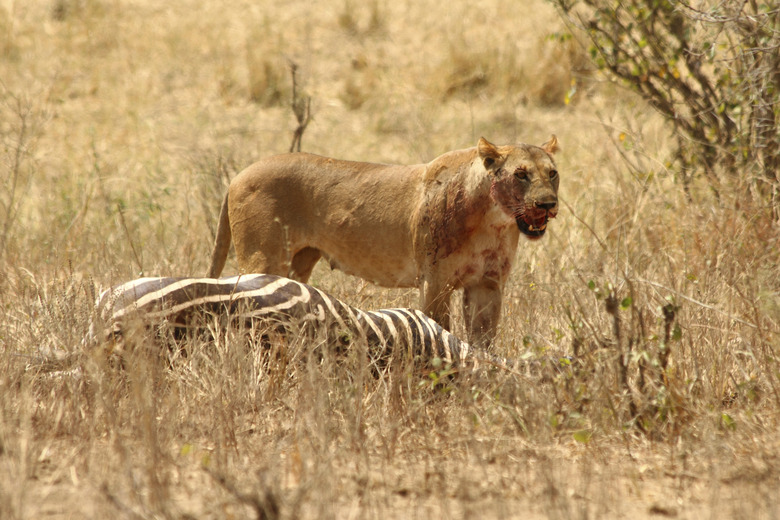How Does A Food Chain Affect An Ecosystem?
A food chain symbolizes the path of energy within an ecosystem: Primary producers such as green plants translate solar energy into carbohydrates, which are then tapped by primary and secondary consumers and ultimately recycled by decomposers. Each tier represents a different trophic level.
While a food chain model shows a simplified linear sequence, it can be visualized with other interlocking and overlapping food chains in a given ecosystem to create a food web, which illustrates the same idea in a more complex and realistic way.
Fundamental Ecosystem Structure & Function
Fundamental Ecosystem Structure & Function
An ecosystem exists to utilize energy and cycle matter: The former – in most cases, continually resupplied by sunlight and captured by photosynthetic organisms – flows through the trophic levels, while matter is used over and over again.
The eating at the heart of a food chain is how the energy essential for growth and function is accessed by those organisms – called heterotrophs – which can't produce their own fuel. A food chain, therefore, is one of the foundational elements defining and giving shape to an ecosystem.
What Dictates Biomass in an Ecosystem
What Dictates Biomass in an Ecosystem
The model of a food chain or food web also relates to another schematic: the pyramid of numbers. This depicts the relative amount – roughly speaking, the biomass – of producers and consumers in a given ecosystem. Because of the loss due to metabolic activity and the inefficiency of organisms in extracting energy from food, there's less and less available energy at higher trophic levels.
The diminishing energy available at ascending tiers of the biomass pyramid explains, as ecologist Paul Colinvaux famously put it, "why big fierce animals are rare." A food chain girded by countless green plants naturally supports a very small number of apex predators such as tigers or orcas.
Niches and Adaptation Within an Ecosystem
Niches and Adaptation Within an Ecosystem
A niche can be thought of as the ecological role of a particular organism within an ecosystem. Filling specific niches allows more species to coexist in the same habitat matrix and maximizes the use of available energy; adapting to these roles helps drive speciation. Diet is a major determinant of ecological niche, and even fairly subtle differences in dietary preference can permit similar animals to utilize the same environment.
In the Black Hills, for example, large ungulates lessen inter-species competition when sharing winter habitat by targeting different primary food sources: grass for bison, herbs for pronghorn, shrubs for mule deer and a mixture of grasses and herbs for elk. African herbivores also provide a fantastic example of niche utilization. Giraffes feed at the tops of trees where other herbivores cannot reach, kudu and other browsers feed on the lower branches and shrubs, while zebra and other grazers eat the grasses.
Interactions Between Predator and Prey
Interactions Between Predator and Prey
A food chain in operation helps regulate an ecosystem. Prey species frequently overgraze the plant life and become overpopulated with the removal of their primary predators. The predators keep the prey populations in check and prevent overpopulation and disease. However, the interactions between predator and prey also have more complex implications when you consider the trophic level of the predator.
Predators don't always directly control the size of their prey population – they may bolster its relative health by removing diseased or otherwise impaired individuals. The mesopredator release hypothesis suggests that midlevel predators (or mesopredators) increase in number and influence when the top predators that once controlled them are removed from an ecosystem.
This may have significant ripple effects on the food web. Some examples of the mesopredator release hypothesis in action include: increased predation on sea turtle eggs in Florida by ghost crabs when raccoons (which eat both crabs and eggs) were controlled and the decimation of the East Coast bay scallop industry by cownose rays as the sharks that preyed on them declined due to overfishing.
Cite This Article
MLA
Shaw, Ethan. "How Does A Food Chain Affect An Ecosystem?" sciencing.com, https://www.sciencing.com/food-chain-affect-ecosystem-10013447/. 30 September 2021.
APA
Shaw, Ethan. (2021, September 30). How Does A Food Chain Affect An Ecosystem?. sciencing.com. Retrieved from https://www.sciencing.com/food-chain-affect-ecosystem-10013447/
Chicago
Shaw, Ethan. How Does A Food Chain Affect An Ecosystem? last modified August 30, 2022. https://www.sciencing.com/food-chain-affect-ecosystem-10013447/
